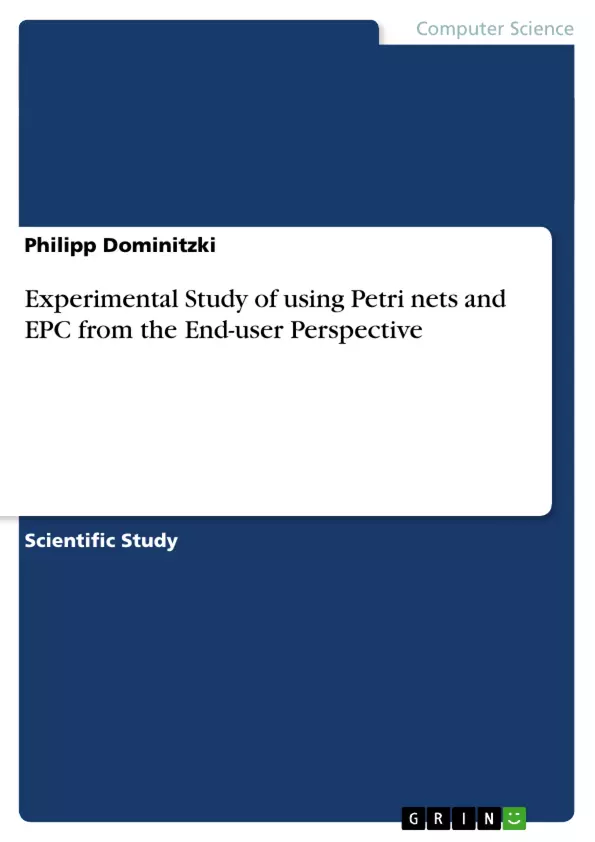In winter semester 2003/04 a seminar working paper about the ‘relevance of the laboratory experiment in MIS research’ was generated, based on an empirical literature study. One result was that this method is generally established within information systems in the English-speaking language area (especially in the data modeling domain and the formal versus non-formal contestation). But surprisingly practically no experimental studies could be found, using the laboratory experiment as research method in process modeling. Based on this cognition, in summer semester 2004 the project EXPEND (Experimental Study of using Petri nets and EPC from the End-user Perspective) was started, intending to realize an experimental study just in that research environment. As a framework for the further study, a comparison of the two process modeling languages EPC and Petri nets (in particular C/E nets) from the end-user perspective was given. Another important target for the study is, in addition to the principle realization of an empirical laboratory experiment, to prove or disprove some of the most prominent hypothesis in the theoretical literature discussion between the supporters of the semiformal EPC and the formal Petri nets. Their theoretical background, justification and transfer to provable hypothesis form the following theoretical framework chapter 2. Because using the laboratory experiment in the data modeling research provides a set of similarities, the approaches from GREEN, PETRE and BELLAMY and from MOHER, MAK and BLUMENTHAL provided a basic proceeding guideline for the study on hand. Both workgroups compared the comprehensibility of Petri nets against textual program representations within a laboratory experiment. Chapter 3 illustrates the specific experimental design used for the study on hand. In chapter 4, the results of the data analysis and statistical tests for the particular hypothesis are illustrated and discussed. The over-all concluding and comprising discussion forms the closing chapter 5.
Inhaltsverzeichnis (Table of Contents)
- Motivation and Task
- Theoretical framework
- Levels of representation and formalism
- Focus on the End-User perspective
- Research questions and resulting hypotheses
- Experimental Design and Methodology
- Basics of the Laboratory Experiment
- Subject information
- Procedure of the experiment
- Data analysis basics
- Data analysis and result discussion
- Sub question 1: Difficulty of EPC's OR connector
- Sub question 2: Difficulty of the EPC's event element
- Sub question 3: Difficulty of identifying concurrencies in Petri nets
- Sub question 4: Usefulness of the tokens in Petri nets
- Sub question 5: Acceptability of the modeling language
- Sub question 6: Over-all superiority of the EPC
- Non-hypothesis related and non-planned results
- Concluding discussion
- Acknowledgements
- Literature
- Appendix
Zielsetzung und Themenschwerpunkte (Objectives and Key Themes)
This project report aims to investigate the usability of Petri nets and Event-driven Process Chains (EPC) from an end-user perspective. The study utilizes a controlled laboratory experiment to assess the effectiveness and comprehension of these modeling tools by analyzing user performance and feedback.
- Evaluating the usability of Petri nets and EPCs for modeling business processes
- Examining the cognitive challenges associated with understanding and applying these modeling techniques
- Assessing the impact of different modeling elements on user comprehension and performance
- Comparing the effectiveness of Petri nets and EPCs in representing and communicating complex business processes
- Exploring the potential benefits and limitations of each modeling approach for end-users.
Zusammenfassung der Kapitel (Chapter Summaries)
- Motivation and Task: This chapter introduces the research topic and outlines the project's goals. It provides a rationale for investigating the usability of Petri nets and EPCs from the end-user perspective.
- Theoretical framework: This chapter lays the foundation for the research by discussing the theoretical underpinnings of Petri nets and EPCs. It explores different levels of representation and formalisms used in process modeling and emphasizes the importance of considering the end-user perspective.
- Experimental Design and Methodology: This chapter details the design and execution of the laboratory experiment conducted to gather data for the research. It describes the participants, experimental procedure, and data analysis methods employed.
- Data analysis and result discussion: This chapter presents and analyzes the results obtained from the laboratory experiment. It explores the findings in relation to the research questions and hypotheses, examining the difficulties encountered by participants with specific modeling elements and providing insights into user preferences and perceptions of the two modeling approaches.
Schlüsselwörter (Keywords)
The core concepts and keywords of this research include Petri nets, Event-driven Process Chains (EPC), usability, end-user perspective, laboratory experiment, process modeling, business processes, cognitive challenges, modeling elements, and comparative analysis.
- Citation du texte
- Dipl.-Kfm. Philipp Dominitzki (Auteur), 2005, Experimental Study of using Petri nets and EPC from the End-user Perspective, Munich, GRIN Verlag, https://www.grin.com/document/38394



